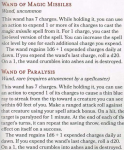Two different weapons and maybe a ranged weapon for flying enemies is perfectly fine. But having a cold iron weapon, a good weapon, a chaotic weapon, a fire weapon etc etc?
To me, it feels like a lot of old challenges were rooted in 'gotcha!' mechanics and were rendered moot by enough system mastery, especially in relation to spells.
It's interesting to note that a lot of what made old challenges 'challenging' like not having the right spell prepared at the right level, were rendered moot by giving the casters a boost to their flexibility. I find it ironic you, who want the Wizard to be better, complain the game is too easy at the same time
I don't know why a +3 Ice Burst Sword wouldn't be Magical if not used as a sword. Just make it a +3 Icy Burst Club. I mean, in 5e a Greatsword is a two handed 2D6 weapon. A Greatclub is two handed 1D8. Seem like a fair drop in effectiveness if used as a blunt instrument.
On your first point, That's why I liked eberron's addition of byeshek & flametouched iron. Byeshk let you overcome the dr on "daelkyr"(basically aberrations) & flaemtouched iron counted as good(so undead, fiends, etc) without the alignment needs of holy/lawful/chaotic weapons so if you carried a bludgeoning, a slashing & piercing weapon with one of them being flametouched iron ad another byeshek you were probably good against everything but damage specific stuff like skeleton & zombie had even if those metals weren't your +3 icy burst greatsword named glacier's edge. I don't remember a lot of fey players were likely to battle & ctrl-f in the 3.5 mm only lists a handful of goodish low level types.
things like level drain /ability damage/etc weren't so much rendered moot by having the right spell prepared because greater restoration was something a level thirteen cleric could cast once, while lesser spells like lesser restoration only helped recover faster than 1 point per day. That also certainly had nothing to do with the fact that con & other ability damage was hitting a pool of what was likely to be ~10-20something with d6 damage as opposed to a much larger pool of 60-80+ hitpoints. If multiple people wound up with ability score damage that's going to be a big hit to the group & not something you could just solve by getting a single good night's sleep. Take the wraith though, switching from ability score damage to hp reduction that goes away after a good nap was only part of what changed since the 5e wraith is no longer ignoring armor & takes a 14 to hit off the rack plate+shield making it harder to get and trivial to remove
On the wanting wizard more powerful point, I think you are probably misinterpreting some stuff said elsewhere or reading in some of your own biases as implied with things not said. Switching from prepared vancian to spontaneous casting absolutely changed the cost of many mitigating spells, keeping all spell slots recovered after a good night's sleep while simultaneously changing it so you recover all hp after that sleep threw off the balance in other areas though & shifted the cost of using those mitigating spells to near zero. Getting away from subjective things like meaningful dr, ability damage, incorporeal traits & so on... look at how that affects healer's kit dependency & slow natural healing from dmg 266 & 267.
Yes there is the gritty realism dial
Some of these problems created by spontaneous casting as the norm could have been fixed by using things like the spell slot recovery rate from ad&d(?) where it took a number of days(hours?) times the level of spell slot you were preparing a spell for with each spell/spell slot; but doing that would run back into gritty realism's problems & possibly create problems of its own. Healer's kit dependency suddenly looks a lot more impactful when everyone with a cure spell & unused spellslots is hesitant to start a rest with the words "I've got xyz spell slots unused who needs healing" because that 111122 s slot burn is going to take 8 hours, 8 days, or whatever & still won't even touch the spell slots they burned being a $class so better stock up on healing kits.





